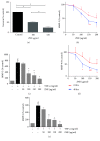Ziziphus nummularia Inhibits Inflammation-Induced Atherogenic Phenotype of Human Aortic Smooth Muscle Cells
- PMID: 28593025
- PMCID: PMC5448155
- DOI: 10.1155/2017/4134093
Ziziphus nummularia Inhibits Inflammation-Induced Atherogenic Phenotype of Human Aortic Smooth Muscle Cells
Abstract
Cardiovascular disease (CVD) continues to be the leading cause of death worldwide. Atherosclerosis is a CVD characterized by plaque formation resulting from inflammation-induced insults to endothelial cells, monocytes, and vascular smooth muscle cells (VSMCs). Despite significant advances, current treatments for atherosclerosis remain insufficient, prompting the search for alternative modalities, including herbal medicine. Ziziphus nummularia is an herb commonly used in the amelioration of symptoms associated with many health conditions such as cold, diarrhea, cancer, and diabetes. However, its effect on the inflammation-induced behavior of VSMCs remains unknown. In this study, we sought to determine the effect of the ethanolic extract of Z. nummularia (ZNE) on TNF-α-induced phenotypic changes of human aortic smooth muscle cells (HASMCs). The treatment of HASMCs with ZNE decreased cell proliferation, adhesion to fibronectin, migration, and invasion. ZNE treatment also caused a concentration- and time-dependent reduction in the TNF-α-induced expression of matrix metalloproteases MMP-2 and MMP-9, NF-κB, and cell adhesion molecules ICAM-1 and VCAM-1. Furthermore, ZNE decreased the adhesion of THP-1 monocytes to HASMCs and endothelial cells in a concentration-dependent manner. These data provide evidence for the anti-inflammatory effect of Ziziphus nummularia, along with potential implications for its use as an agent that could ameliorate inflammation-induced atherogenic phenotype of VSMCs in atherosclerosis.
Figures







References
-
- Douglas G., Channon K. M. The pathogenesis of atherosclerosis. Medicine. 2010;38(8):397–402. doi: 10.1016/j.mpmed.2010.05.002. - DOI
-
- Wang T., Palucci D., Law K., Yanagawa B., Yam J., Butany J. Atherosclerosis: pathogenesis and pathology. Diagnostic Histopathology. 2012;18(11):461–467. doi: 10.1016/j.mpdhp.2012.09.004. - DOI
MeSH terms
Substances
LinkOut - more resources
Full Text Sources
Other Literature Sources
Medical
Miscellaneous

